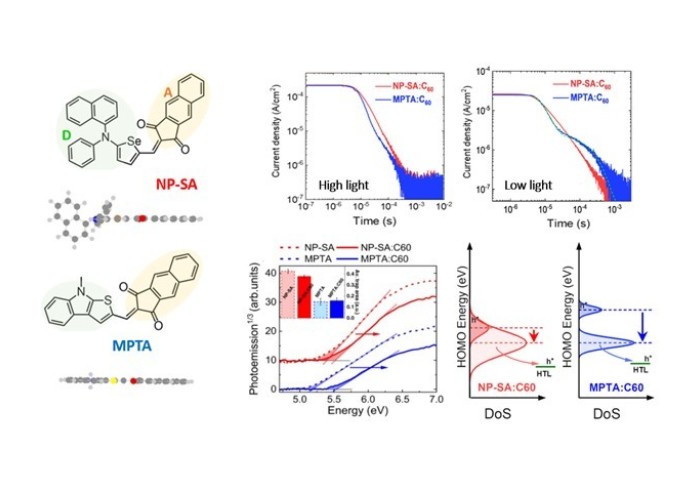
Materials for efficient photodetectors

CPE researchers have investigated the role of molecular geometry in the creation of different types of trap states.
Photodetectors are optoelectronic devices generating an electric current in response to a specific light stimulation, and they are now widespread in many daily-life applications – from smartphone cameras to blood oxygen sensors. Beyond limitations of traditional silicon technology, organic semiconductors are greatly promising for the new generations of photodetectors, due to their tuneable absorption, cheap fabrication and attractive mechanical properties.
However, organic photodetectors (OPDs) typically suffer from slow photodetection, which is a major issue for high-frequency applications. This is due to the highly disordered nature of organic semiconductors, where the electric charges can get “stuck” before being extracted out of the device – a phenomenon known as charge trapping. To optimise OPD performance, it is therefore crucial to minimise the presence of trap states (i.e., the species responsible for charge trapping), especially when the devices are utilised under low level of light intensity – such as indoor or night conditions.
Researchers at Imperial College London, in collaboration with Samsung Advanced Institute of Technology have investigated the role of molecular geometry in the creation of different types of trap states. In their study, they systematically compared the performance of OPDs where a planar or a twisted small molecule is used in combination with fullerenes. They found that the planar molecular design yields excellent performance when the device is operated under high light intensity (e.g., solar illumination), due to better order in the semiconductor film and faster transport of electric charges. However, the planar molecules can aggregate between each other and also react with fullerenes, and this results in additional trap states which deteriorate OPD operations under low light intensity. Through this work, the researchers suggest that considering the illumination conditions where the device would be applied is crucial to select the optimum molecular design for OPD materials.
“Light-intensity-dependent photoresponse time of organic photodetectors and its molecular origin”, by Chiara Labanti, Jiaying Wu, Jisoo Shin, Saurav Limbu, Sungyoung Yun, Feifei Fang, Song Yi Park, Chul-Joon Heo, Younhee Lim, Taejin Choi, Hyeong-Ju Kim, Hyerim Hong, Byoungki Choi, Kyung-Bae Park, James R. Durrant and Ji-Seon Kim is published in Nature Communications.
Article link: https://www.nature.com/articles/s41467-022-31367-4
Article text (excluding photos or graphics) © Imperial College London.
Photos and graphics subject to third party copyright used with permission or © Imperial College London.
Reporter

Lisa Bushby
Department of Physics



